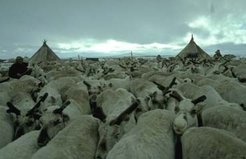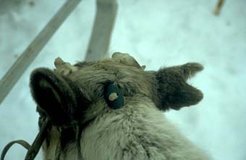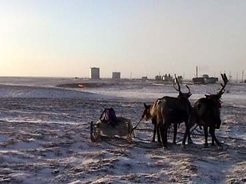Property and Economy among reindeer herders in Yamal, Northwest Siberia
Project Summary

The Yamal-Nenets Autonomous Okrug at the first glance looks like a success story in reindeer herding, continuing even in the difficult times of transformation after the Soviet Union. The number of domestic reindeer is constantly increasing, up to 523 000, which is the largest concentration in Russia and the world. Selling the main production of reindeer, meat and 'panty' (fresh antlers), is no problem for the herders, since private commercial enterprises compete with the still existing 'Sovkhozy' (state farms). Thus, reindeer herding provides a secure basis for economic existence and the indigenous cultural identity of the herders. Such a development is unique in the Post-Soviet Russian North, where reindeer herding in all other regions either collapsed or is experiencing a major crisis. It is even more remarkable, given that Yamal provides 90% of the Russian natural gas production and the share of the native population is only 5 %.
My dissertation project at the Max-Planck Institute with the working title “When nomads meet the market: Property and Economy among reindeer herders of Yamal, Northwest Siberia”, tries to look behind the facade of this “success story” , with particular attention being paid to the nature of property relations in land and animals among the Yamal-Nenets, and the way in which they engage in the evolving market economy of the region.

During a one year field research in the Yamalo-Nenetskii Autonomous Okrug (the official term for my field site region), I wanted to find out how this “success story” looks like at the grassroots, in the tundra and the Polar Ural mountains. In living with the nomadic reindeer herders and taking part in their interactions with the Russian sedentary population, the administration and the oil and gas industry, I wanted to discover the human and other basic components responsible for this development.
The tundra population of Yamal are Khanty, Komi, but mainly Nentsy reindeer herders, who migrate throughout the year with big herds of several thousand deer through the Tundra, the Forest-Tundra south to the arctric circle and the polar Ural mountains. Throughout the Russian North it is in this region, where reindeer herding is thought to be preserved in its most original way. This is mostly due to the Nentsy, and the Northern Khanty have partially adapted this herding style from them.
Rather than further contributing to further construct a “secret of the Nentsy”, how the origins of their success deeply lie in something called “their culture”, I try to put together a mosaic of all relevant factors outside and inside of these pastoralists’ world, which could in their combination be the reason for such an unusual development in the region.
Property and Economy among reindeer herders in Yamal, Northwest Siberia

During my fieldwork, I tried to cover a range of organisational forms of reindeer herding, having worked among formerly state owned enterprises, the sovkhoz brigades as well as with private herders, members of registered clan-communities (obshchina, cf. Gray) and herders employed by commercial reindeer processing enterprises. The focus of this work was the herders’ perceptions of the soviet past and the transitional processes around them and their strategies of making use of the recent developments. To answer the main question of herding success by encountering property relations and market economy, the main part of the fieldwork consisted of nomadic migration with the herders. Apart from this participant observation and narrative interviews, I collected data through a micro-survey of 25 reindeer herding households. This survey consisted mainly of questions on property regarding land and animals, patterns of land use, especially migration routes, and strategies to act in the recently evolving market economy.

The institutional framework of all these perceptions was covered by interviews with the people working at different levels of administration, with directors of reindeer enterprises, and regional policy-makers. The material gathered here was, apart from personal viewpoints of the interview partners, mainly on regional and local legislation. Reindeer breeding should also not only be seen in its meaning for the herders or in political programs, but also in its contribution to the region as a whole. Therefore, statistics on herd sizes, forms of property in reindeer, and the share of the migrating herders were gathered on all levels starting from the local administrative unit and ending in Moscow for the whole Russian Federation.
Property and Economy among reindeer herders in Yamal, Northwest Siberia
Preliminary Results

Analysis of the complex field work data shows, that the statistics collected and the perceptions of the herders are broadly consistent. A number of factors seems to determine Yamal’s starting point at the beginning of market-oriented reindeer herding: Yamal throughout the Soviet times had the biggest share in privately owned reindeer, and herders themselves clearly opted for the development of their private herds after the Soviet union.
There is, thus, an uninterrupted history of private herds and herders from Tsarist times up to the present day. As far as land is concerned, the same continuity is observable. Although the Soviets reorganized reindeer herding, the pattern of seasonal migration from Tsarist times up to the present remains largely the same. To continue these patterns, herders clearly opt for common access to pastures that can be flexibly negotiated. This makes the Yamal case interesting in the discourse on mobile pastoralism. Private property with exclusive rights to pastures is seen as a threat to the very existence of reindeer herding.

This view is shared on practically all levels, from the tundra nomad to the President of Russia’s reindeer herders’ association. However, this brings two dangers, first the ‘tragedy of the commons’ described by Hardin (1968). The findings of this research support the well known criticism to Hardin, that common use of pastures does not mean an ‘open-access’ regime, but that use is negotiated within an authorized group of users (cf. Casimir 1992: 8f). Another problem seems to be more dangerous for the ecology of the region than the herders’ system of common pastures with flexibly negotiated usufruct rights. Without officially being registered as land owners, reindeer herding communities are in a weak position in the recent competition with oil and gas companies over land rights. The reaction of the herders and their supporters in the village is the creation of registered clan based communities (obshchiny) that could have a better position in applying for a land title or in negotiations with companies. The foundation of these obshchiny started in regions with resource extraction. The further northwards extraction plans move, the further northwards registrations of obshchiny can be observed. This suggests seeing obshchiny as a means to defend land rights in a situation of growing competition. This supports Dyson-Hudson and Smith’s ‘economic defendability model’, stating that the more scarce and valuable a resource becomes, the more you invest in exclusive control over it.
Property and Economy among reindeer herders in Yamal, Northwest Siberia

An uninterrupted experience in herding and living of their own reindeer, a common use of pastures allowing them flexibly to adapt their migration routes to ecological as well as social pressures and a clever sense of negotiation and finding their niche within a centralized state systems were the factors that enabled the Yamal reindeer herders to preserve their pastoral lifestyle to such an extent, that they are called today as being the most ‘traditional’. At the other hand, the findings also show, that this has only become possible within the Soviet Union, because the state in its regional behavior was not so strict and oppressive as the ideology and Moscow orders let it assume. As reported for Hungary by Hann, the Socialist state and the local population came to informal agreements to satisfy both needs: Reindeer herders were allowed to have their own ‘supplementary economy’, and the state could use the surplus of this economy to fulfill the centrally prescribed quota.
Having in mind this background, it becomes less of a miracle, why Yamal herders soon after the breakdown of the planned economy succeeded rather well in marketing their reindeer meat and antlers (panty) to various competitors. In the first decade after the Soviet Union, reindeer herding was the most stable branch of the local economy, so that more and more families opt for a live on the tundra rather than in the villages with material and social problems common throughout the whole former Soviet bloc.
References
Casimir, Michael 1992. The Dimensions of Terrioriality: An introduction, in: Casimir, Michael; Rao, Aparna (ed.): Mobility and Territoriality: Social and Spatial Boundaries among Foragers, Fishers, Pastoralists and Peripatetics. New York and Oxford (Berg publishers), pp. 1-26.
Dyson-Hudson, Rada; Smith, Eric Alden 1978. Human territoriality: an ecological reassessment, in: American Anthropologist 80: pp 21-41.
Gray, Patty 2001. The Obshchina in Chukotka: Land, Property and Local Autonomy. Working Paper No. 29, MPI Halle.
Hann, Chris: Internet Project description. MPI Halle (draft).
Hardin, Garett 1968. The tragedy of the Commons, in: Science 162:pp. 1243-1248.






